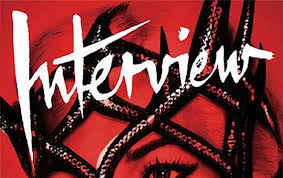New York City Ballet
 Water Flowing Together (documentary)
Water Flowing Together (documentary)This is the story of a remarkable dancer, Jock Soto, who retired from the New York City Ballet at age 40, after a 24-year career.
Soto's journey as an openly gay man of Navajo Indian and Puerto Rican descent provides a rare glimpse into the life of a dancer and the disparate worlds which have shaped this important artist.
I actually think it’s very funny sometimes, putting on the makeup and then putting on the tights and then putting on your costume and then I look in the mirror and think, 'This is such an odd occupation for a 40-year-old man.'
Better that I decide that it's enough than somebody else telling me that it's time, or reading it in the newspaper.
Water Flowing Together - official site
 The Superman of Dance
The Superman of DanceJock Soto, leading dancer of the New York City Ballet, has taken partnering into realms of sleight-of-hand undreamed of before him. Short and solidly built, inscrutably dark-featured, half-Navajo Indian and half-Puerto Rican, this man does not resemble the usual slender-lined ballet prince, yet throughout his career ballerinas queued up to be partnered by him, and when he gave his final performance at the age of 40 last month in New York's State Theatre, they were queueing up again, to shower him with red roses.
 Jock Soto & Wendy Whelan
Jock Soto & Wendy Whelan Jock & Wendy
Jock & Wendy Jock & Wendy
Jock & Wendy Jock Soto & Miranda Weese
Jock Soto & Miranda WeeseWhy Jock Soto Has Been the Perfect Partner
Mr. Soto, 40, who has danced with City Ballet since 1981 and has been a principal since 1985, has an astonishing sixth sense: he is a born partner, the finest that has graced the company since Peter Martins himself. There are no fussy moments in a Soto pas de deux. His talent lies in what you don't see happen: his partners don't fall off point or make unsightly wobbles in a pirouette, and knowing that he is in charge let's them jump higher, spin faster and take risks with musical phrasing. [...]
Gia Kourlas asked a few of Mr. Soto's favorite partners, past and present, to explain exactly how he made them look good...
Darci Kistler: Some male dancers only care about their solos, but Jock cares about the whole picture. He knows what I'm going to do before I do it, and that allows me to be fully in the music with no broken line, no distraction. You're dancing with a partner, but at the same time neither one of you feels the other. I've never felt him touch me! The sensation is like little butterfly kisses.
Heather Watts: A few years before I retired, I asked Peter: 'What's the matter with my arabesque? When Jock puts me in arabesque, I feel O.K.' And he said: 'Yeah, because he puts you there. You don't have the muscle to get there by yourself. . . . At 15, Jock knew where my balance was better than I did.
Lourdes Lopez: You know when you partner and your skirt gets tangled up? I have been in front of Jock Soto when he actually moved the chiffon so that my skirt fell nicely. When I danced with him in 'The Nutcracker,' my tutu was never, ever crushed.
Wendy Whelan: He knows who he's dancing with and he really focuses on her strengths and weaknesses. As partners I think we have a very languid power. He's sturdy and strong, but also very free in a certain way, and I'm more stretchy, but I also have that grounded strength. We make one whole circle, and it's a weird, interesting balance.
Miranda Weese: You can do anything, and it's almost like nothing will go wrong. If it does, he will fix it. You actually find yourself absolutely letting go. There are times I would get off the stage and almost not even realize that I had danced because I was that lost in it.
 Ballet.co Review
Ballet.co ReviewI will confess that back in the day I wasn't much taken with Soto. Although not at all short, his body type was far from ideal for ballet, especially Balanchine's school, which so strongly emphasizes the line of the leg and fleetness of foot. With his stocky proportions, long-torsoed and short-legged, Soto didn't look particularly Balanchinian (especially next to dancers like Peter Martins, Adam Luders, Daniel Duell or Ib Anderson). Indeed, if it hadn't been for his immediate use as the Designated Partner for Heather Watts (a rather formidable handful), it's questionable whether he'd have gotten into City Ballet at all. As Watts, a dancer of squandered talent whose movement quality was like the screech of fingernails on a blackboard, was perhaps my least-favorite dancer of all time, I couldn't help but view Soto with some of the distaste I felt for her. "He has no business being here," I sniffed.
After a hiatus of about a dozen years, I returned to City Ballet a bit chagrined to discover that Soto, through sheer hard work, had transformed himself into a dancer of sensitivity and power, with an unforced yet commanding presence emanating from the great strength of his unflappable center. Moreover, building from his days partnering Watts, Soto had become the Best Partner in the World. Great partners are valuable anywhere, but especially so in City Ballet, with its repertory largely shaped by Balanchine's veneration of the ballerina. Ashton once said that watching 'Sleeping Beauty' served as a lesson in choreography (and) to watch Soto was to observe an advanced treatise in the art of partnering. Here, his not unsubstantial physique only helped our perception of him to match what he'd in fact become: a pillar of strength, in all senses of the word. [...]
Soto will continue to teach at the School of American Ballet, where his fiendishly hard men's and partnering classes are as popular with students as his performances were with City Ballet's audiences.
Jock Soto at the School of American Ballet Winter Ball (vid)
Sokvannara "Sy" Sar
Pacific Northwest Ballet



Sokvannara Sar performs to Philip Glass's "The Other Side" during opening night of the 2008 Vail International Dance Festival. [plumtv.com]
Dancing Across Borders - official site
This documentary tells the story about a charismatic, young Asian trailblazer named Sokvannara “Sy” Sar. As a youth performing traditional folk dances in Cambodia in 2000, he gains the attention of filmmaker Anne Bass, who sees his tremendous talent and decides to bring him to New York City so he can study ballet.
Highly skeptical at first, his passion for ballet grows as does his natural ability to pick things up quickly — in only three years. His first ballet teacher from Russia beams with pride when she talks about the experience of training the young man from Angkor Wat. She said, “It happens once in a lifetime.”
Bass’ debut film is filled with Sar’s amazing performances throughout his dance career, including photographs and video of him as an apprentice for the Pacific Northwest Ballet in 2006.
Interviews with Sar as well as his instructors clearly present the message that this is no ordinary ballet dancer. Forget that he’s usually the only Asian onstage. While Sar briefly discusses many of the hardships he’s faced in order to study ballet, the documentary does not look into these hardships with the drama that is inherently involved in each of them. But for fans of dance and ballet, Bass’ film succeeds in presenting a good story about one of its brightest stars. [nwasianweekly.com]























